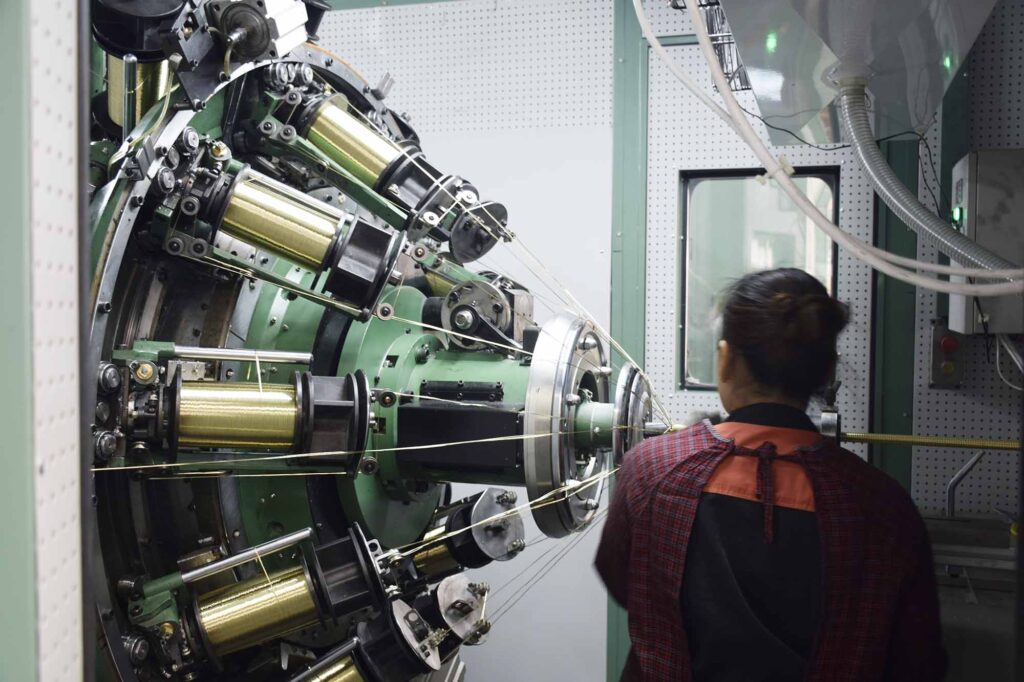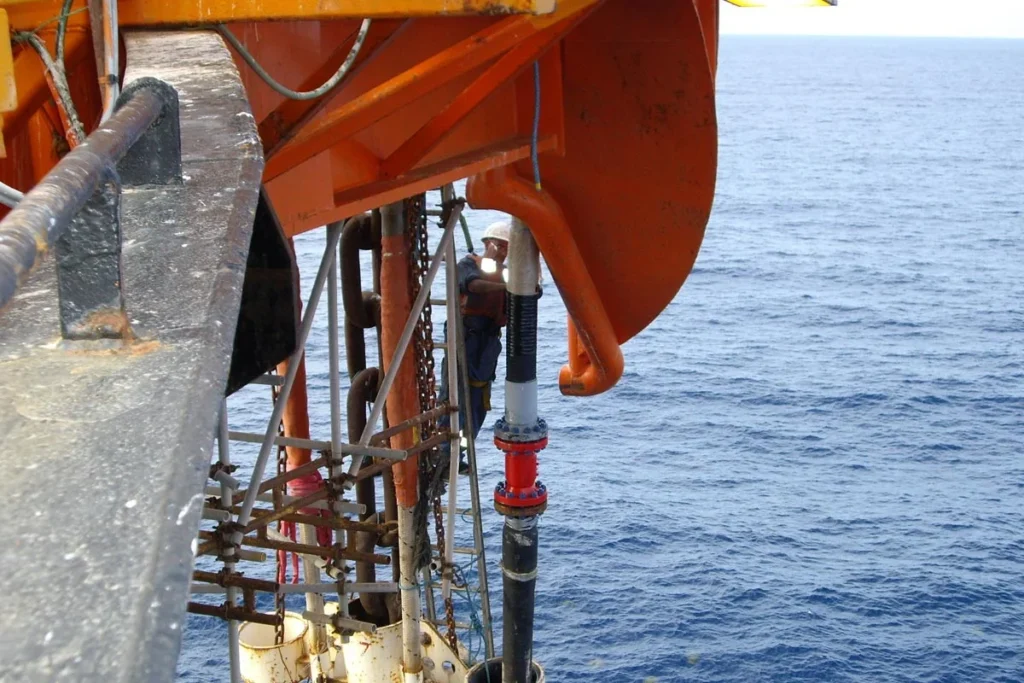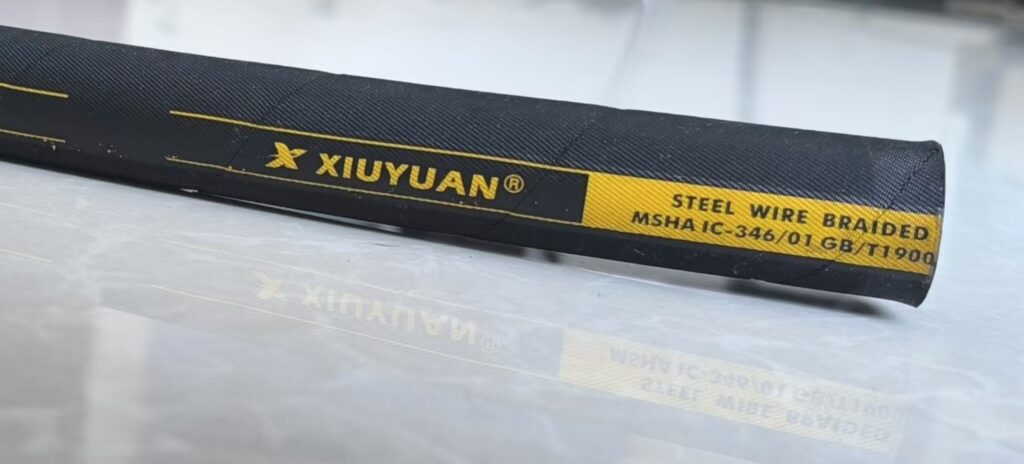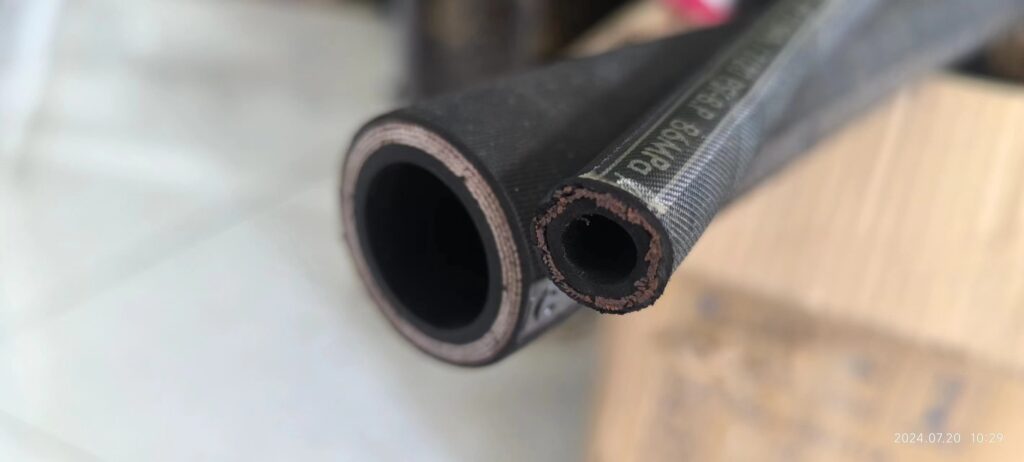Hdraulic rubber hose is divided into two kinds of high-pressure hose and low-pressure hose. High-pressure hose is generally composed of four parts: outer rubber layer, steel wire reinforcement layer, middle rubber layer and inner rubber layer. The inner rubber layer is in direct contact with the hydraulic oil, generally made of synthetic rubber. The bearing capacity of the hose depends on the strengthening layer, the layer is the skeleton of the hose, usually made of steel wire braid or winding. Medium and high pressure most of the steel wire braid for the skeleton, high pressure, ultra-high pressure more steel wire winding skeleton. The outer rubber layer is generally made of wear-resistant, corrosion-resistant rubber to ensure that the reinforcing layer is not subject to mechanical damage, chemical corrosion, moisture rust, low-pressure hose to braided cotton, twine instead of braided steel wire, generally used for low-pressure oil return pipeline.
Hose failures generally manifest themselves in the following three areas: failure of the outer layer, failure of the inner tube, failure of the reinforcement layer.
The causes of hydraulic hose failures and countermeasures are described below:
Failure of the outer layer
(1) Lower temperatures, cold environment, the temperature of objects plummeted, hydraulic hose is no exception, the hose exterior once the cracks, will make the hose by bending. If you find a crack on the outside of the hose, pay attention to whether the rubber inside the hose cracks, and decide whether to replace the hose immediately.
(2) Bubbling on the exterior of the hose. The appearance of the hose bubble is due to the quality of the hose is not eligibility or improper use. If the bubble appears in the middle of the hose, mostly for the hose production quality problems. Should be replaced in a timely manner qualified hose; if the hose appears in the hose connector, is likely to be due to improper installation of the connector.
(3) The hose is not ruptured, but a lot of oil seepage. If the hose is not found rupture, but a large number of oil seepage, the reason is that the hose through the high-pressure liquid flow, the inner rubber was erosion, abrasion, until a large area of leakage out of the steel wire layer resulting in a large number of oil seepage.
(4) The outer rubber layer of the hose is seriously deteriorated, and the surface is slightly cracked. This is the performance of the natural aging of the hose used for too long.
Failure of the inner tube
(1) The rubber layer inside the hose is hard and cracked. Due to the plasticizer added to the rubber product, it makes the hose flexible and plastic. The hose works under high temperature and high pressure, and overheating of the hose will cause the plasticizer to overflow. In addition, when the overheated oil passes through the cylinders, valves or other components in the system, if a large pressure drop is generated it will cause the oil to decompose, resulting in oxidation and hardening of the rubber layer inside the hose. Encountered this situation, should first check the hydraulic system operating temperature is normal, valve throttle, pump suction channel is through, etc., in order to rule out all possible factors that may lead to high oil temperature and oil decomposition after the replacement of the hose.
(2) serious deterioration of the rubber layer in the hose, obviously swelling. Serious deterioration of the rubber layer in the hose, obviously swelling is due to the use of hydraulic oil over time or oxidized and deteriorated dirt exists in the hydraulic system, the hose is subjected to chemical action and deterioration, in the oil back to the mouth of the crumbled rubber pieces will be found. If the phenomenon occurs, should check the physical and chemical indicators of the hydraulic oil, check the system fluid in the hose rubber material compatibility and working temperature is in line with the standard.
Failure of the reinforcement layer
(1) Ruptured hose. Rust of braided steel wire near the rupture. If the hose rupture, peel off the outer rubber layer inspection found near the breach of the braided, twisted steel wire rust, which is mainly due to the role of the outer rubber layer of moisture or corrosive substances, the exploitation of the strength of the hose, resulting in high pressure when the rupture. This situation, generally accompanied by the outer layer of fracture, abrasion or serious deterioration of the phenomenon, so that the outer layer has lost the protective effect of the reinforcing layer. At this time, we must first check and exclude the mechanical damage to the outer layer, chemical corrosion and high-temperature baking and other undesirable factors, and then replace the hose. However, there are cases where the outer rubber layer remains good but the reinforcing layer is rusted and ruptured. And the rupture is usually within 200mm from the hose connector, the reason is that most of the connector is not qualified, due to moisture into the inner edge of the jacket, so that the reinforcing layer to absorb moisture, resulting in rust caused by the reduction of the pressure strength of the hose and rupture.
(2) The reinforcing layer of the hose is not rusty. But there are irregular broken wire phenomenon if the hose rupture, peel off the outer rubber layer check did not find the reinforcing layer of rust, but the length of the reinforcing layer appeared irregular broken wire, the reason is mainly the hose is subjected to high-frequency impact. Braided reinforcing layer of steel wire in the steel wire between a lot of intersections, when the tube pressure changes, these intersections are also with the changes in the diameter of the tube and the wrong, so that the steel wire friction between each other. If the hose is subjected to high-frequency impact pressure, frequent friction occurs at the intersection, resulting in wire breakage. Frequent friction occurs at the intersections, resulting in breakage of the steel wire. For hoses subjected to frequent high-frequency impacts, a wire-wound skeleton should be used as a reinforcing layer.





